Last, but absolutely not the least, is adding intelligence to the beast. Considering the budget constraints and simplicity of integration I decided by using a Fonera 2100 router as the workhorse for processing data. Equipped with a single chip Atheros solution, the integrated 32-bit MIPS R4000-class processor runs at 183.5 MHz, and is tipically enough for most network processing that is required. Additionally the IEEE 802.11b / 802.11g WiFi interface provides the means for remote communication with the vehicle. For local communication it features both an Ethernet interface, and a 3.3 V serial port.
Ad
Thursday, March 25, 2010
Cognition on Wheels
Last, but absolutely not the least, is adding intelligence to the beast. Considering the budget constraints and simplicity of integration I decided by using a Fonera 2100 router as the workhorse for processing data. Equipped with a single chip Atheros solution, the integrated 32-bit MIPS R4000-class processor runs at 183.5 MHz, and is tipically enough for most network processing that is required. Additionally the IEEE 802.11b / 802.11g WiFi interface provides the means for remote communication with the vehicle. For local communication it features both an Ethernet interface, and a 3.3 V serial port.
Thursday, March 11, 2010
Let there be light!
One of the most pleasant situations is when can execute an idea without using any of your budget. It occured to me that having some onboard lightsource could be useful for the car, specially if you plan on doing night driving. Well I took a look at my repository of electronic junk, and found a pcb with 9 white leds from a broken flashlight, and a bunch of broken 9g microservos.
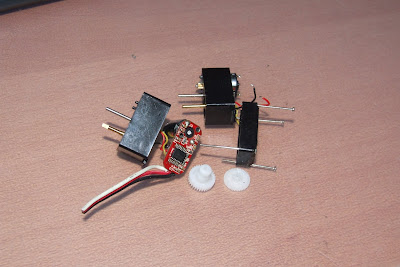
So I thought, well...if I could get the leds to be turned on and off through a free channel on my radio, it would be sweet.. And then took a look at one of the servos, and thought: I remove the motor, replace the encoder pot with a set of resistors, connect the leds in series with a small value resistor, and it should do the trick.
And so I did it: first analysed the servo operation in its original form. Connected the motor to an oscilloscope, and verified that a PWM signal that varies in duty cycle is fed to the motor. The further you move the stick, the more the duty cycle approaches 100%. Without surprise the peak voltage would be 5 V at the motor terminals (the same voltage that powers the servo).
Measured the pot resistance, which was 2 KOhm. Measured the current consumed by the leds while being fed with 3.1 V (minimum voltage for enough luminosity). It would draw 60 mA.
Then all I had to do was applying Ohm's law to find the appropriate resistor to drop the voltage, given the current that we know the LEDs consume. Found that the ideal value was 52 Ohms (V=RI <=> R = V/I <=> R = 3.1 / 0.060 = 51.66 ~ 52 Ohms).
I did't had this value (the closest resistor is 51 Ohms), so I used the closest resistor I could find at hand. Found a 47 Ohm, which in spite of being slightly smaller, it shouldn't harm the leds as I was being conservative with the voltage in the first place (these were being used in a flashlight powered by 3 AAA batteries - meaning that the voltage could be up to 4.5 V). The typical voltage to which white LEDs are rated is 4 volts.
With a bit of experimentation found an appropriate value for the resistors replacing the pot. One 2 K resistor between pin 1 and pin 3 of the pot terminal, and a 1 K resistor between pin 1 and pin 2.
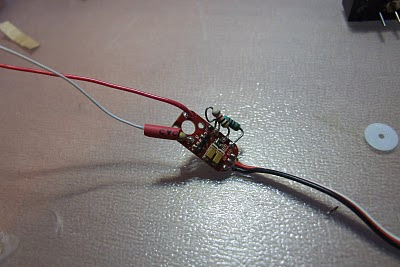
By doing this I trick the servo controller into thinking that the motor is always in the same position, while the user commands it to go to a different position. This causes the controller to continuously provide current to the motor, in an attempt to reach the desired position. Here instead of the motor we put the LEDs. The result is the LEDs being constantly lit while the stick is in a given region, and off in the remaining positions (because a negative voltage is fed to the LEDs - if a motor would be present instead, it would cause it to move in a different direction).
A little bit of soldering, and it was done! This way I had the cheapest possible RC headlight without spending a single cent.
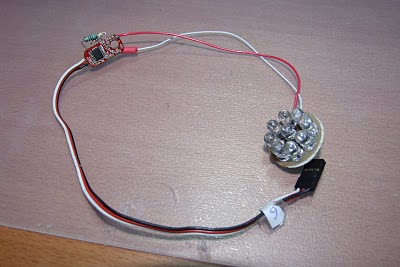
And finally, after putting heatshrink around the PCB, the work was done:

So I thought, well...if I could get the leds to be turned on and off through a free channel on my radio, it would be sweet.. And then took a look at one of the servos, and thought: I remove the motor, replace the encoder pot with a set of resistors, connect the leds in series with a small value resistor, and it should do the trick.
And so I did it: first analysed the servo operation in its original form. Connected the motor to an oscilloscope, and verified that a PWM signal that varies in duty cycle is fed to the motor. The further you move the stick, the more the duty cycle approaches 100%. Without surprise the peak voltage would be 5 V at the motor terminals (the same voltage that powers the servo).
Measured the pot resistance, which was 2 KOhm. Measured the current consumed by the leds while being fed with 3.1 V (minimum voltage for enough luminosity). It would draw 60 mA.
Then all I had to do was applying Ohm's law to find the appropriate resistor to drop the voltage, given the current that we know the LEDs consume. Found that the ideal value was 52 Ohms (V=RI <=> R = V/I <=> R = 3.1 / 0.060 = 51.66 ~ 52 Ohms).
I did't had this value (the closest resistor is 51 Ohms), so I used the closest resistor I could find at hand. Found a 47 Ohm, which in spite of being slightly smaller, it shouldn't harm the leds as I was being conservative with the voltage in the first place (these were being used in a flashlight powered by 3 AAA batteries - meaning that the voltage could be up to 4.5 V). The typical voltage to which white LEDs are rated is 4 volts.
With a bit of experimentation found an appropriate value for the resistors replacing the pot. One 2 K resistor between pin 1 and pin 3 of the pot terminal, and a 1 K resistor between pin 1 and pin 2.
By doing this I trick the servo controller into thinking that the motor is always in the same position, while the user commands it to go to a different position. This causes the controller to continuously provide current to the motor, in an attempt to reach the desired position. Here instead of the motor we put the LEDs. The result is the LEDs being constantly lit while the stick is in a given region, and off in the remaining positions (because a negative voltage is fed to the LEDs - if a motor would be present instead, it would cause it to move in a different direction).
A little bit of soldering, and it was done! This way I had the cheapest possible RC headlight without spending a single cent.
And finally, after putting heatshrink around the PCB, the work was done:
Wednesday, March 3, 2010
Intelligence on wheels
Robotic vehicles are not a novelty. Initial attempts to create autonomous roving machines date back to the 1970's, with examples such as Stanford cart in 1961 and Shakey, Moravec in 1979. These were simple machines. Digital computers were not yet miniaturized to the point of enabling interesting computing power onboard a vehicle, regardless of its practical size. Even so, the state of the art of the technology at that time proved sufficient to allow the mankind to explore new fronteers of a universe never before crossed by human artifacts. Two such examples were the NASA Voyager I and II missions. Having passed the 30 year mark in space, these prodigious machines still beam back health reports to earth, and should continue to be up and running until the energy generated by the plutonium based RTG (Radioisotope Thermovoltaic Generator)is insufficient to power the essential electronic systems onboard (of which one of the most important ones is the radio transmitter). This should occur anywhere in the next 10 years.
Today we have the result of tremendous technological improvements since the time the Voyager spacecrafts had been created. However, achieving the same degree of reliability is a milestone not always achieved in every case, regardless of how much extra knowledge the humanity have been gifted with.
While trustworthiness is not necessarily a consequence of innovation, it must be in the agenda, as long as the outcome is intended to be a dependable solution.
Anyway, the focus of this post is more on innovation itself rather than discussing trustworthiness and reliability. I am presenting a small part of what one day will be with us everywhere.
We are surrounded by automatic machines in our daily lifes. Even where it's less obvious. The small capsule called elevator, that takes us from one floor to another is one such example. While it doesn't look like a robot, it is a very autonomous machine. Equipped with clever microcontrollers, elevators are capable of making logical decisions, while multiple users request its attention. It's a simple example of a machine that in its current state of evolution is driven by an electronic computer, has sensors, and is capable of triggering actions (e.g.: activate a motor) based on a predefined plan, or in response to external input (e.g.: pressing a button). It can be enabled with useful optimizations such as having the ability to position itself automatically in different floors, depending on the selective demand at diferent times of the day, within a building.
Robots are intended to be useful for the human being, not to replace him. Through automatic machines we moved from one point to another in our ability to produce more and better artifacts, and to provide better services to people.
In this blog post I am presenting you with a machine that, while functional, is still the first step for achieving a helper robot, the hopefully will be the base platform for making very interesting household applications for machines this size.
I started from buying a cheap supermarket toy RC car. It called my attention the fact that besides its low cost, it was large (1:10 scale), had very nice looking wheels, and featured a 850 mAh 10 Volt lead acid battery (so most likely it also had a motor rated for 10 Volts or more):
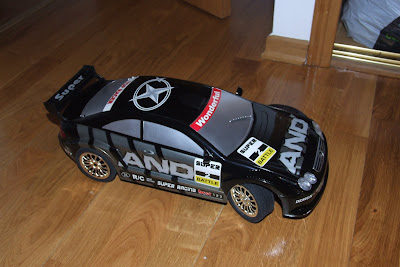
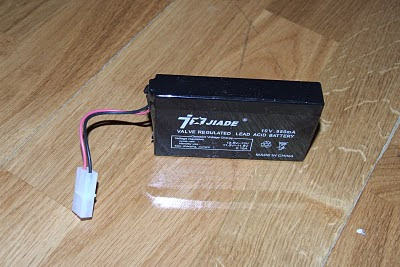
Of course the lead acid battery would not be very interesting as my future power solution, but we'll return on that later on. I decided to buy this car for the features managed to discriminate.
After fully charging the lead acid battery, I tested the car, still in its original form. I noticed that it really had nice torque and plenty of raw power. However, it lacked the ability to harness the beast. Like with most toy R/C cars, it's circuitry only allows zero or full throttle to be applied, both in forward and reverse directions. This, of course besides being very limited, also translates to prematurely worn and damaged gears. On the other hand the steering was also very poor. It was also zero or full travel in both directions. Of course we cannot expect proportional controls for a 25 Euro car! Well, I tested the car for, say, 1.5 minutes, and the battery soon started to gradually drop the delivered power. I was admired, either the battery had very poor quality or the motor was an animal.
I decided to start the transformation. I had a few spare hobby R/C parts such as a few microservos, a Art-tech 41 MHz 6 ch. receiver used in model helicopters and planes and a 11.1 V 1300 mAh battery (the stock battery from my Falcon 3D heli).
I started by removing all the crap out of the car, until I got this:
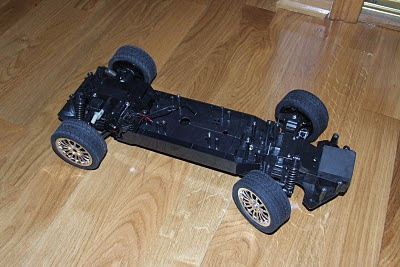
Here is the circuit board with the receiver and motor control. Here I had already removed the two SPDT relays used for reverse. Take a look at the big resistor (feer):
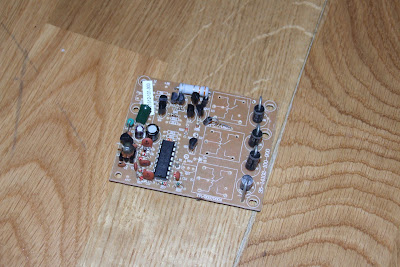
The original steering motor:
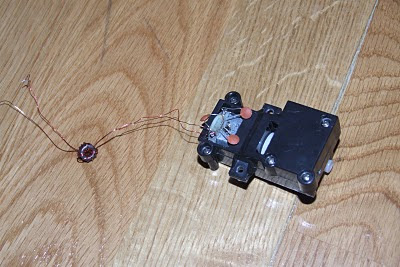
It hardly had torque to turn the wheels, specially after 1 minute of battery use.
The transmission motor yes, had quite a punch. I measured it's current while connected to the fully charged battery, it draws 1.5 A free running, and 13 A under full load (zero RPM on the shaft). So it consumed 130 Watts of power. The output power should therefore be around 100 Watts, assuming it's a reasonably efficient brushed motor.
I still needed a brushed motor ESC and better servo for the steering. I searched the web for DIY ESC solutions, and found this, which seemed interesting:
http://www.designsoft.com.au/ahome/rc/PIC-ESC/ESC.html
It featured design variations for both cars and planes. It seemed exactly what I needed, and I calculated that it shouldn't be hard to build and expensive. I had the option of choosing the relay or the H-bridge reverse. As I still had the two SPDT relays from the original circuit, I decided to try this version, as it would be slightly cheaper. Already in an advanced stage of the assembly:
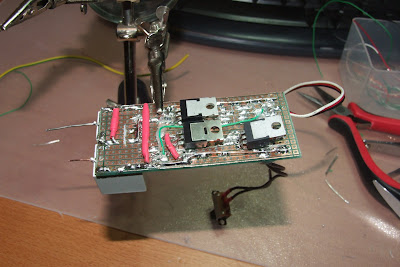
And the top view, with the two white relays:
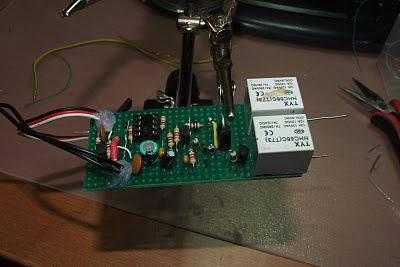
After building the hardware it was time to program the PIC:
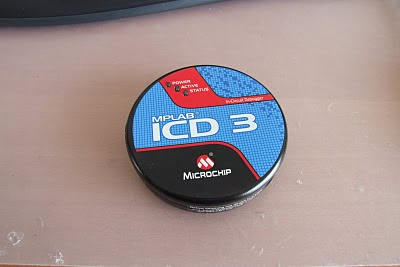
I had to build a small board with the ICSD socket for the PIC, as the ICD 3 is not provided with one:
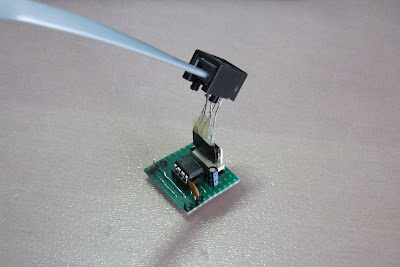
Mounted the 41 MHz radio and the LIPO battery. Both fitted nicely into the original
battery compartment:
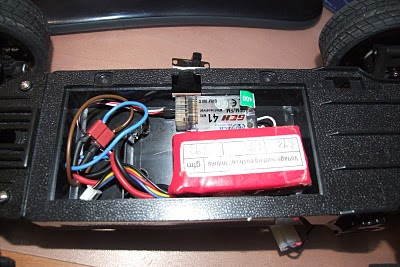
Mounted the 43 g standard servo (it has 6.5 kg of torque). Replaced the original links with ball links. Adapted the steering bar in order to attach the servo arm through a ball link:
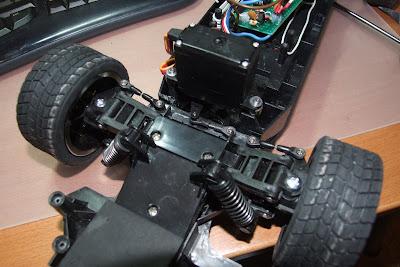
After a few more assembly iterations, mounted a virgin pcd board to be used as a plate for scientific instruments, and attached a gymballed support for a 1.2 GHz wireless camera. The gymball was assembled manually with aluminium. It uses two microservos to provide pitch and yaw for the camera. This is the result:
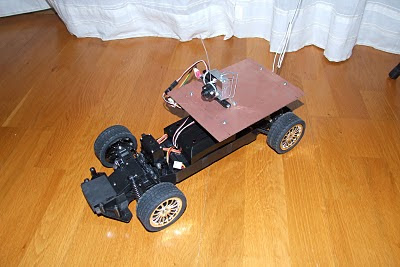
A detail view of the camera, which is also powered from the LIPO battery, through a regulator board I have also assembled (located in the bottom of the virgin pcb). It provides +5 V and +9 V necessary for the camera (camera and transmitter respectively):
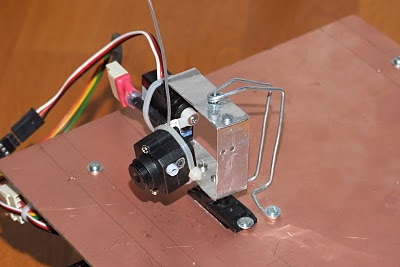
The car is then controlled by a standard PPM 6 ch transmitter (41 MHz):
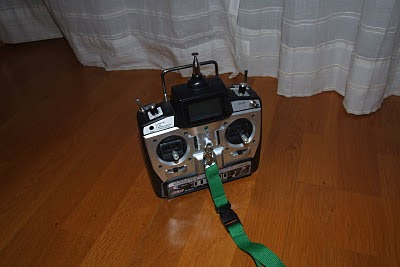
After the assembly, it was time for a test drive! Turned on the camera, connected the 1.2 GHz analog video receiver to a home made patch antenna, and time to hit the road..errmm...the wooden pavement..
As the car moved away from the place where I was controlling it, signal weakening and multipath interference became apparent. Some servos glitch violently under signal interference...dumb radio... The ESC on the other hand doesn't react because it properly filters occasional glitches.
Today we have the result of tremendous technological improvements since the time the Voyager spacecrafts had been created. However, achieving the same degree of reliability is a milestone not always achieved in every case, regardless of how much extra knowledge the humanity have been gifted with.
While trustworthiness is not necessarily a consequence of innovation, it must be in the agenda, as long as the outcome is intended to be a dependable solution.
Anyway, the focus of this post is more on innovation itself rather than discussing trustworthiness and reliability. I am presenting a small part of what one day will be with us everywhere.
We are surrounded by automatic machines in our daily lifes. Even where it's less obvious. The small capsule called elevator, that takes us from one floor to another is one such example. While it doesn't look like a robot, it is a very autonomous machine. Equipped with clever microcontrollers, elevators are capable of making logical decisions, while multiple users request its attention. It's a simple example of a machine that in its current state of evolution is driven by an electronic computer, has sensors, and is capable of triggering actions (e.g.: activate a motor) based on a predefined plan, or in response to external input (e.g.: pressing a button). It can be enabled with useful optimizations such as having the ability to position itself automatically in different floors, depending on the selective demand at diferent times of the day, within a building.
Robots are intended to be useful for the human being, not to replace him. Through automatic machines we moved from one point to another in our ability to produce more and better artifacts, and to provide better services to people.
In this blog post I am presenting you with a machine that, while functional, is still the first step for achieving a helper robot, the hopefully will be the base platform for making very interesting household applications for machines this size.
I started from buying a cheap supermarket toy RC car. It called my attention the fact that besides its low cost, it was large (1:10 scale), had very nice looking wheels, and featured a 850 mAh 10 Volt lead acid battery (so most likely it also had a motor rated for 10 Volts or more):
Of course the lead acid battery would not be very interesting as my future power solution, but we'll return on that later on. I decided to buy this car for the features managed to discriminate.
After fully charging the lead acid battery, I tested the car, still in its original form. I noticed that it really had nice torque and plenty of raw power. However, it lacked the ability to harness the beast. Like with most toy R/C cars, it's circuitry only allows zero or full throttle to be applied, both in forward and reverse directions. This, of course besides being very limited, also translates to prematurely worn and damaged gears. On the other hand the steering was also very poor. It was also zero or full travel in both directions. Of course we cannot expect proportional controls for a 25 Euro car! Well, I tested the car for, say, 1.5 minutes, and the battery soon started to gradually drop the delivered power. I was admired, either the battery had very poor quality or the motor was an animal.
I decided to start the transformation. I had a few spare hobby R/C parts such as a few microservos, a Art-tech 41 MHz 6 ch. receiver used in model helicopters and planes and a 11.1 V 1300 mAh battery (the stock battery from my Falcon 3D heli).
I started by removing all the crap out of the car, until I got this:
Here is the circuit board with the receiver and motor control. Here I had already removed the two SPDT relays used for reverse. Take a look at the big resistor (feer):
The original steering motor:
It hardly had torque to turn the wheels, specially after 1 minute of battery use.
The transmission motor yes, had quite a punch. I measured it's current while connected to the fully charged battery, it draws 1.5 A free running, and 13 A under full load (zero RPM on the shaft). So it consumed 130 Watts of power. The output power should therefore be around 100 Watts, assuming it's a reasonably efficient brushed motor.
I still needed a brushed motor ESC and better servo for the steering. I searched the web for DIY ESC solutions, and found this, which seemed interesting:
http://www.designsoft.com.au/ahome/rc/PIC-ESC/ESC.html
It featured design variations for both cars and planes. It seemed exactly what I needed, and I calculated that it shouldn't be hard to build and expensive. I had the option of choosing the relay or the H-bridge reverse. As I still had the two SPDT relays from the original circuit, I decided to try this version, as it would be slightly cheaper. Already in an advanced stage of the assembly:
And the top view, with the two white relays:
After building the hardware it was time to program the PIC:
I had to build a small board with the ICSD socket for the PIC, as the ICD 3 is not provided with one:
Mounted the 41 MHz radio and the LIPO battery. Both fitted nicely into the original
battery compartment:
Mounted the 43 g standard servo (it has 6.5 kg of torque). Replaced the original links with ball links. Adapted the steering bar in order to attach the servo arm through a ball link:
After a few more assembly iterations, mounted a virgin pcd board to be used as a plate for scientific instruments, and attached a gymballed support for a 1.2 GHz wireless camera. The gymball was assembled manually with aluminium. It uses two microservos to provide pitch and yaw for the camera. This is the result:
A detail view of the camera, which is also powered from the LIPO battery, through a regulator board I have also assembled (located in the bottom of the virgin pcb). It provides +5 V and +9 V necessary for the camera (camera and transmitter respectively):
The car is then controlled by a standard PPM 6 ch transmitter (41 MHz):
After the assembly, it was time for a test drive! Turned on the camera, connected the 1.2 GHz analog video receiver to a home made patch antenna, and time to hit the road..errmm...the wooden pavement..
As the car moved away from the place where I was controlling it, signal weakening and multipath interference became apparent. Some servos glitch violently under signal interference...dumb radio... The ESC on the other hand doesn't react because it properly filters occasional glitches.
Subscribe to:
Posts (Atom)
